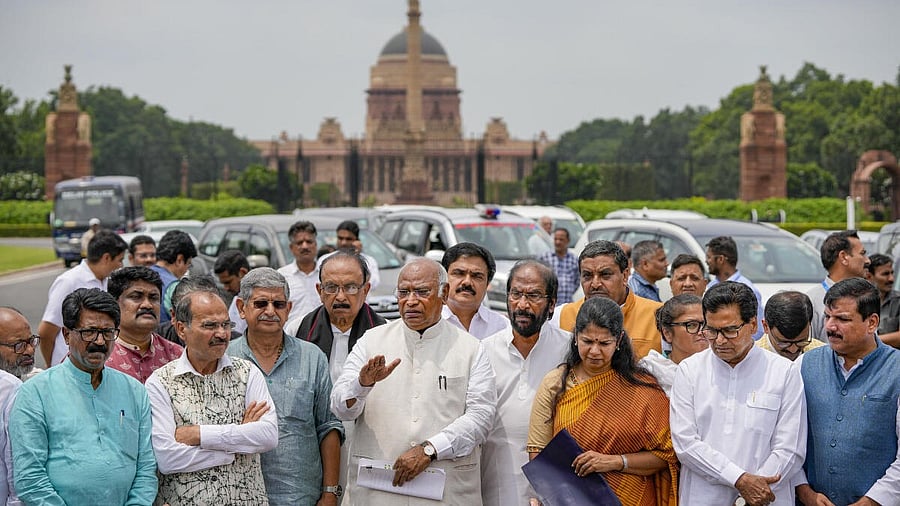
Mallikarjun Kharge with other I.N.D.I.A leaders.
Credit: PTI Photo
There were some signs of life in the Uttar Pradesh unit of the Congress when its new state chief declared that Rahul Gandhi and Priyanka Gandhi Vadra must contest from the state.
In the 2022 assembly elections, despite an intense campaign by Priyanka Gandhi Vadra, the Congress slumped to its worst ever performance of two seats (of 403) and 2.3 per cent of the vote. In the 2019 Lok Sabha polls, Rahul Gandhi lost his traditional seat of Amethi. The state has, therefore, delivered consecutive blows to the first family of the Congress.
The black hole staring at the joint Opposition platform (I.N.D.I.A) is Uttar Pradesh, where it’s possible to conceive of the BJP improving its tally. In February, the Bharatiya Janata Party (BJP) gave a team of central leaders the responsibility of overseeing a plan to win each of the seats it had lost in 2019— 16 of the 78 seats it contested — although in two subsequent byelections, the BJP wrested two seats from the SP.
In 2019, the BJP won 49.5 per cent of the vote in Uttar Pradesh and the BJP-led National Democratic Alliance (NDA) won 64 seats, while the Congress won 6.3 per cent vote and only Sonia Gandhi won from Rae Bareli for the party. The Samajwadi Party (SP), then in alliance with the Bahujan Samaj Party (BSP), won five seats. The BSP won 10 seats, but since then the Mayawati-led party has been in freefall, and is not part of any joint opposition strategy.
In other big states, the BJP is being challenged, and there is a possibility of reduced numbers from Bihar, Maharashtra, and West Bengal, besides Karnataka where it lost the recent assembly polls.
There are multiple reasons why Uttar Pradesh, like Gujarat, has emerged as a bastion/Hindutva fortress for the BJP. Two sections of society have been dislocated for different reasons — with different consequences. First, the Muslims estimated to be nearly 20 per cent of the population, are passive even in pockets where they are numerically strong. There are diminishing returns for any party that seeks minority support and anecdotal evidence suggests the Muslim names most frequently are among those that go missing from voter lists.
Second, the Dalits make up about 21 per cent of Uttar Pradesh’s population and the winding down of the BSP has resulted in many of them losing their natural political choice — consequently turning to the BJP. The BJP’s free ration outreach has been a lifeline for the poor and the consciousness of subaltern communities has shifted, albeit for now, from seeking rights and social justice to becoming beneficiaries.
The Narendra Modi-Amit Shah model in Uttar Pradesh is a coalition of extremes: it caters to the highest castes which are estimated to make up 20 per cent of the population, of whom 10 per cent are Brahmins; but while the Brahmins and the Thakurs (Chief Minister Yogi Adityanath’s community) are in positions of power disproportionate to their numbers, there is also some form of material benefit for the poor. The OBCs and the Dalit votes are still divided, but many are also now included in the Hindutva project — which gives a psychological sense of belonging and the street cred of a foot-soldier.
There is a perception in Uttar Pradesh that the Opposition cannot win. In the 2022 assembly elections, the SP, led by Akhilesh Yadav, had a tailwind as there was a belief it could defeat the BJP — this was why so many small caste-based political parties had an alliance with the SP. The SP got its highest vote share, yet the BJP got 10 per cent more votes. Since then that alliance has withered away, with the BSP broken and the SP demoralised.
Adityanath’s bulldozer politics, the frequent encounters of politician-criminals, and the criminalising of protest has also contributed to a sense of fear in the Opposition ranks. The only way this mood can be lifted is if the I.N.D.I.A alliance, particularly the Congress, starts winning in the upcoming state elections. If that happens the Opposition could set up a common secretariat where all the parties, including those who have formidable networks in the south, could start working with the SP/Congress and allies on the ground in Uttar Pradesh.
There is no way of breaching the BJP’s fortress in Uttar Pradesh unless there is a strategy to work on the technical parts of the elections — from voter lists to booth management to social media messaging in individual seats by pooling resources. Naturally, the Congress would be part of this bloc, and it makes imminent sense for Rahul Gandhi to again contest from Amethi as his image in 2024 has improved from what it was in 2019.
It has also been suggested that Priyanka Gandhi Vadra contest against Modi in Varanasi: there is little chance of defeating the Prime Minister in that seat, but she could make a symbolic show of also being a candidate there, while replacing her mother from Rae Bareli.
(Saba Naqvi is a journalist and author.)
Disclaimer: The views expressed above are the author's own. They do not necessarily reflect the views of DH.